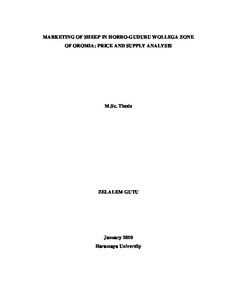This is a Land Lease Agreement posted on <a href="https://www.openlandcontracts.org:443/">OpenLandContracts.org</a>. It lists Biofuels,Oil crops,Other crops as the primary…
The pastoral areas of Ethiopia are witnessing radical change in terms of both increasingly restricted mobility and access to vital resources. A cause and consequence of such constraints has been a move toward sedentarised forms of livestock and agricultural production. This is occurring in a…
Sheep production is an integral part of the subsistence crop-livestock systems of Ethiopian highlands and plays crucial role in economic development and poverty reduction. So far, there have been very limited efforts exerted to introduce and promote market oriented sheep production and hence the…
This is a Land Lease Agreement,Translated Contract posted on <a href="https://www.openlandcontracts.org:443/">OpenLandContracts.org</a>. It lists Cotton,Sesame,Soybeans (…
This is a Land Lease Agreement posted on <a href="https://www.openlandcontracts.org:443/">OpenLandContracts.org</a>. It lists Cotton,Sesame,Soybeans (Soya beans) as the…
This is a Land Lease Agreement posted on <a href="https://www.openlandcontracts.org:443/">OpenLandContracts.org</a>. It lists Rice as the primary resource(s)
Book
In recent years access to safe and reliable water supplies has received increased government attention in Ethiopia. As a result, the national coverage rate for this service has gradually improved. Yet millions of people in rural areas still do not get drinking water from an improved water source…
Effective poverty reduction programs require careful measurement of poverty status. Several studies have shown conceptually that assets reflecting productive capacity form a more robust basis for identifying the poor than do flow variables such as expenditures or income. Nonetheless, little work…
Eighty-three percent of the population of Ethiopia depends directly on agriculture for their livelihoods, while many others depend on agriculture-related cottage industries such as textiles, leather, and food oil processing. Agriculture contributes about 46.3 percent of gross domestic product (…
The outbreak and spread of Asian-lineage highly pathogenic avian influenza (HPAI) from Asia to Europe and Africa in 2003-2007 challenged national disease surveillance and response programs particularly in those countries where infection occurred. Ethiopia has not had the disease, but it is…
In this discussion paper, we explore the policy environment related to rural-urban linkages and migration in Ethiopia, and analyze how the policies are impacting rural transformation. Section 2 describes conceptual issues and the theoretical framework that establishes the connection between RULs…




